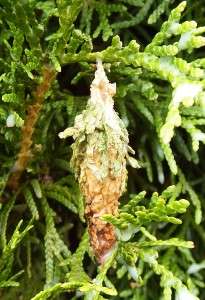Is This Caterpillar
Categories: News
good or bad?
Some insects that feed on the plants in our landscapes are not that damaging. However, some of them, if allowed to go unchecked, can ruin a plant’s ornamental value or actually kill it. We are not necessarily concerned about a few caterpillars that do a little nibbling on some leaves and then turn into a beautiful moth or butterfly, like the Black Swallowtail larva pictured here. These insects help to pollinate the plants that provide much of the food we eat. We need to let these ‘friends’ eat a few leaves and develop into adults for us to enjoy and to fulfill nature’s purpose.
What we need to be concerned about are insects that harm our plants and give us nothing of value in return. These bad critters don’t produce anything we can eat, like honey. Neither do they pollinate flowers that will produce edible fruits or vegetables. These harmful bugs destroy the foliage by either eating it or sucking the juices out of it to the point that the plant is so weakened it eventually dies or is unsightly.
Some examples of insects that cause major damage are mites that can devastate spruce, junipers and boxwood and many other landscape plants. Then there are the borers like the Emerald Ash Borer(EAB) that have killed millions of ash trees as well as borers that affect dogwoods, peach and cherry trees. The harmful insect we want to talk about here is the Bag Worm, not to be confused with Tent Caterpillar or the Fall Web Worm, which are annoying but do not cause any long lasting damage to trees.
 The Bag Worm moves, soon after hatching, by swinging from plant to plant on a strong silk-like thread that blows in the wind. Mother Nature provided this insect with a tough, protective casing. Its “home” is many times mistaken for a pine cone on spruce, pines, arborvitae and other evergreens. It is made of that same strong silk-like thread woven with some of the foliage from the plant the worm is devouring. This “home” moves along with the young worm and keeps it very well camouflaged. The casing is so impervious that pesticides used to kill the insect will not penetrate it. If you want to eliminate this critter, spray / dust with something like Sevin or BT (Bacillus thuringiensis) when the insect is young and coming out of its casing to munch on the plant. Another option is to manually pick the casing off the plant and crush it. (Do not just throw it in the trash or compost. The “home” will simply walk away!) Timing is critical in controlling Bag Worms. If not controlled while young, when coming out of its bag to feed, the caterpillar matures and “holes up” in the casing for the winter. New, young caterpillars emerge in the spring and begin the feeding cycle all over again. These feedings can completely defoliate a plant, usually resulting in its death.
The Bag Worm moves, soon after hatching, by swinging from plant to plant on a strong silk-like thread that blows in the wind. Mother Nature provided this insect with a tough, protective casing. Its “home” is many times mistaken for a pine cone on spruce, pines, arborvitae and other evergreens. It is made of that same strong silk-like thread woven with some of the foliage from the plant the worm is devouring. This “home” moves along with the young worm and keeps it very well camouflaged. The casing is so impervious that pesticides used to kill the insect will not penetrate it. If you want to eliminate this critter, spray / dust with something like Sevin or BT (Bacillus thuringiensis) when the insect is young and coming out of its casing to munch on the plant. Another option is to manually pick the casing off the plant and crush it. (Do not just throw it in the trash or compost. The “home” will simply walk away!) Timing is critical in controlling Bag Worms. If not controlled while young, when coming out of its bag to feed, the caterpillar matures and “holes up” in the casing for the winter. New, young caterpillars emerge in the spring and begin the feeding cycle all over again. These feedings can completely defoliate a plant, usually resulting in its death.
How many bag worms can you find this summer?






Comments are closed.